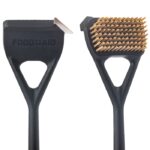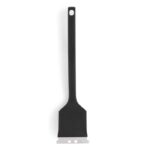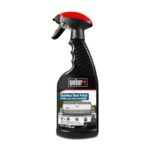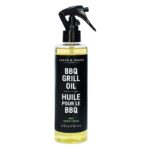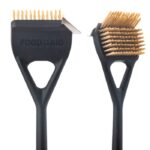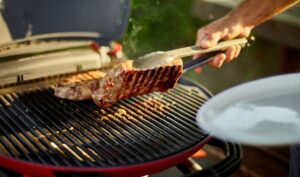We’ve written a lot about cleaning and maintaining different gas grill parts, but there’s one area of the grill we haven’t tackled yet—the lid and the inside of your grill body, also known as the cookbox.
There’s a reason people put off cleaning the inside of their grill—it’s grimy, it’s greasy, and it’s usually a bit more work than cleaning individual parts. But the cookbox and your grill lid can collect a lot of crusty gunk that can seriously impair the performance of your grill—or worse, hasten its demise.
If you’re noticing a lot of flare ups, a weird smell, or more smoke than usual, it’s time to clean the inside of your grill.
In this post, we’ll walk you through the why you should the interior of your grill, and give you a step-by-step guide for how to clean the inside of a gas grill. Let’s get started.
Why Should You Clean Inside of The Grill Lid and Burner Box?
With exposure to high heat, carbon build-up caused by grease and smoke vapor inside your grill will form deposits (known as carbonized grease) on the inside of the grill lid. These deposits will eventually peel, looking very similar to paint. While they are non-toxic, they are unsightly and they can fall onto your food and affect its appearance and taste.
Your cookbox is equally susceptible to build-up—you may not get the same kind of peeling carbon build-up in the cookbox as you’ll see on your grill lid, but grease, food drippings, and other grime will collect over time, creating a thick coating all over the inside of the grill body.
Regularly cleaning the inside of your grill prevents grease fires and flare ups, and it can also make your grill a less enticing environment for pests. But most importantly, a well-maintained grill will simply last longer. The build-up of gunk and grease can speed up the corrosion process, and once the bottom of your grill body rusts out, you’re looking at purchasing a brand new grill.
How To Clean Inside of a Gas Grill
We won’t sugarcoat it—cleaning the cookbox is no easy process. It takes time and some serious elbow grease, but with a bit of effort you can return your grill to its shiny, good-as-new glory.
1. Get your supplies ready
Step one is to collect all of your cleaning supplies. The last thing you want is to have to run around looking for a clean cloth when you’re elbow deep in carbon build-up.
Gather these supplies:
- Rubber gloves
- A grill brush
- A scraper or putty knife (not metal to avoid scratching the grill body)
- At least 2 clean cloths or rags—we recommend cloths you can dispose of after you clean; chances are, you won’t want to use them again
- Dish soap and water mixture (20% dish soap, 80% water)
- Vinegar and water mixture (equal parts vinegar and water), or specialty grill cleaner
- 2 buckets or large containers of clean water—one for a first rinse of your cloth or brush, and one for a second rinse. The first bucket will get pretty dirty, but the second will provide a cleaner rinse.
Shop for grill cleaning brushes:
2. Disconnect the propane tank and remove any parts you can
Disconnect and remove the propane tank so you can clean the interior of the grill cabinet if you’d like. You should remove the propane tank even if you don’t plan to clean the interior cabinet—your grill will be easier to clean without a propane tank to worry about.
Then, remove the grill grates (including the warming rack), heat plates, and burners. Set these aside for cleaning if you plan to clean them as well.
Remove the grease tray and slide a piece of scrap cardboard (or whatever you prefer) into the slot where the grease tray was. Everything you scrape off the lid and grill body will collect on the cardboard, which you can simply remove and toss when you’re done.
3. Start with the lid
Start with the lid so anything you scrape off won’t simply get stuck to a freshly-cleaned cookbox.
Mix a solution of 20% dishsoap and 80% water, then spray the underside of the grill lid. Let it sit for 5 minutes so it can start to dissolve the grease, then scrub thoroughly with your grill cleaning brush. You may need to repeat this process a couple of times depending on how much build-up there is, or tackle it with your scraper or putty knife if you’re having trouble lifting the carbon build-up.
4. Tackle the cookbox
Mix a solution of equal parts vinegar and water. Spray it liberally over all of the crusted-on gunk on the inside of the cook box. Let it sit for a minimum of 5 minutes so the vinegar can start to penetrate the build-up and begin breaking down the grease.
Now it’s time to start scraping. If there’s a lot of build-up (if you haven’t cleaned your cookbox in over a year, for example), a brush won’t cut it. You’ll need a putty knife or scraper to get underneath the layers of cooked-on gunk and grease.
Scrape away as much as you can, then spray with another round of vinegar-water or dish soap-water mixture. Let it sit again, then scrape. Repeat this process till you’re satisfied with how much gunk you’ve removed.
Start high and work your way down the grill body. Push all the gunk through the grease tray opening onto the cardboard sheet.
GRILL SPOT TIP: If things are really caked on, you can make a paste of baking soda and water, apply it to the build-up, then spray with the vinegar-water mixture. Let it sit for a bit, then scrape away.
5. Clean the grill cabinet
Vacuum or sweep out the bottom of your grill cabinet, then wipe with your dish soap mixture. Don’t skip the top of the cabinet doors—these edges can easily collect grease and drippings when you’re grilling.
6. Give everything a final scrub
You’ve come this far! Don’t skip one last scrub. Give everything a final once-over with your dish soap and water mixture so your grill is gleaming. A special grill cleaning solution can make your barbecue sparkle even more.
Shop for grill cleaners:
Get Grilling
Neglecting your grill’s lid and cookbox can have serious consequences for your BBQ’s performance and longevity. The accumulation of carbonized grease and grime can not only affect the flavor of your food, but can also lead to potential hazards like grease fires and flare ups. We know it’s not easy or fun, but cleaning the inside of your grill is a crucial step in ensuring your BBQ works well for years to come.


